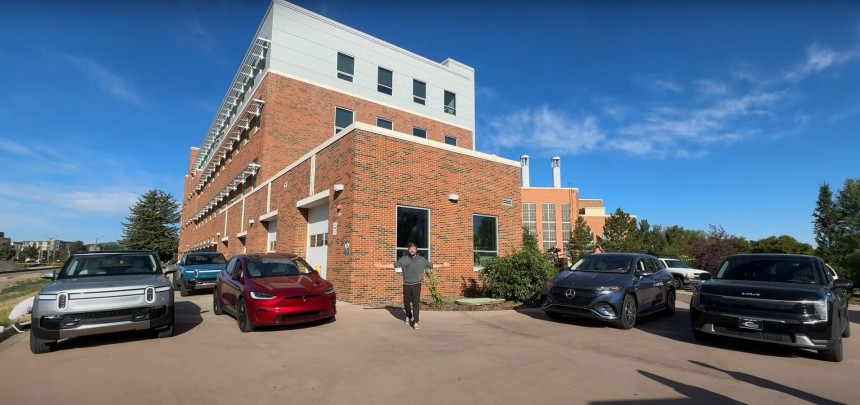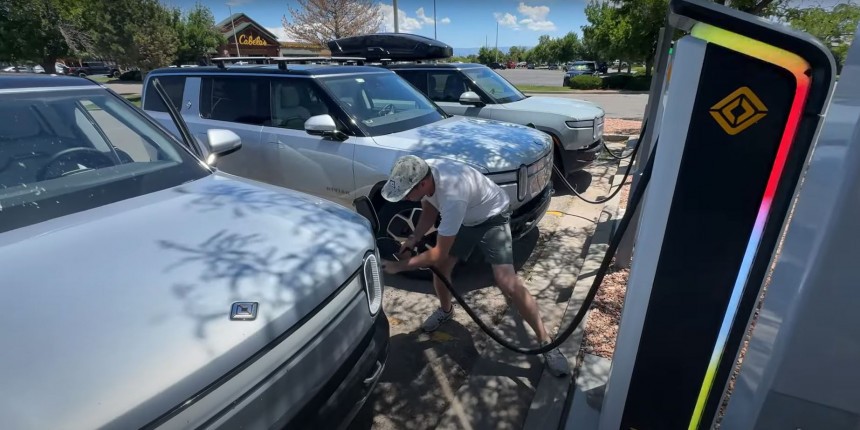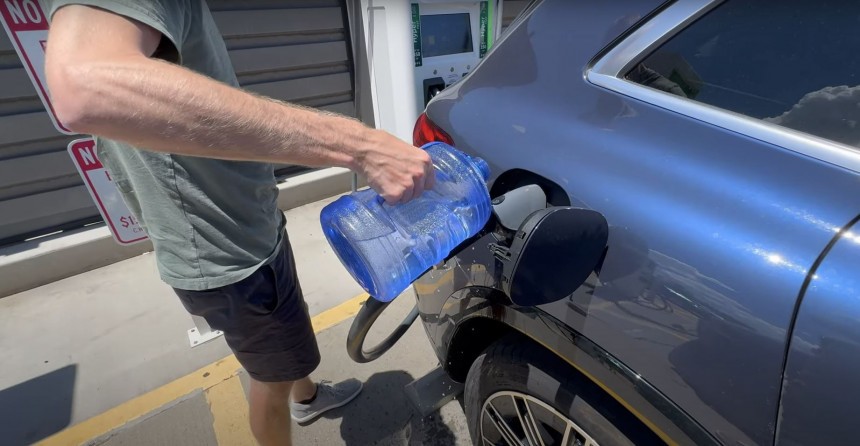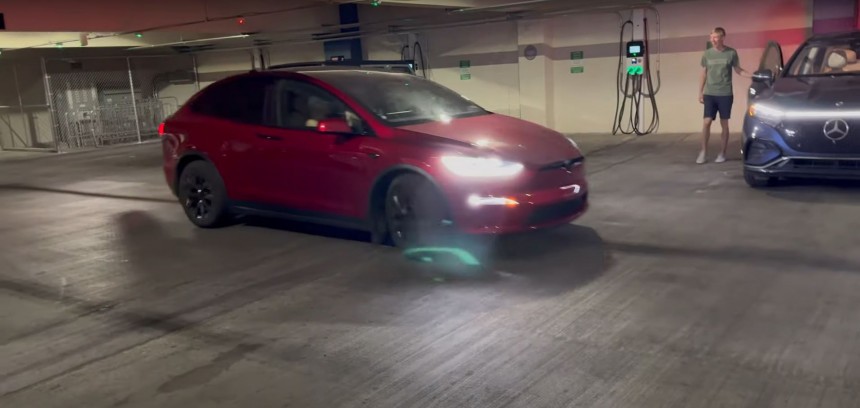Tiring 800-Mile Road Trip Crowns Tesla's Model X As the Best Three-Row Electric SUV
It's no secret that most Americans drive everywhere. The car is the preferred means of transport even when the distance that must be covered is pretty long. But let's say you are planning a summer road trip and want a battery-powered vehicle that can comfortably seat six or seven people. There aren't many options out there, but Rivian, Tesla, Mercedes-Benz, and Kia make some very interesting three-row vehicles. Here's what you should choose.
What happens when you have four all-electric vehicles at your disposal? Well, you can get friends and family together for a pretty exciting journey. That's exactly what the Out of Spec team did, and their efforts brought us a real-world test comprising what can arguably be called the best all-electric three-row eSUV quartet of the moment.
The team envisioned a journey of 800+ miles (1287+ kilometers) that started in Fort Collins, Colorado and ended in Las Vegas, Nevada. The whole point of this exercise? Well, what better way to show which battery-powered SUV is better for your family than an actual road trip through a part of America that is badly in need of some new high-power chargers, right?
It was a challenge for these EVs, but also for the drivers. They had to make sure that their charging strategy was on point. Otherwise, they would risk being stranded on the side of the road and needing to wait for a tow truck or an emergency mobile electric vehicle charging truck.
That would add unforeseen costs to such a journey some might want to make with children or grandparents. Keeping them in the sun with no A/C isn't desirable, to say the least.
Photo: Out of Spec Motoring on YouTube
Facts and figures to remember
So, the stars! The three-row eSUVs used in this test were the:
2024 Kia EV9 Light Long Range // MSRP: $59,200 // Drivetrain: a single 201-hp motor on the rear axle and a 99.8-kWh battery // Wheel size: 19 inches // Odometer: 3,000 miles (4,828 kilometers) // Curb weight: 5,324 lb (2,415 kg);
2024 Tesla Model X Long Range // MSRP: $78,000 // Drivetrain: 670-hp dual-motor all-wheel drive and a 100-kWh battery // Wheel size: 20 inches // Odometer: 10,000 miles (16,093 kilometers) // Curb weight: 5,343 lb (2,465 kg);
2024 Rivian R1S (Gen 1) // MSRP: $94,000 // Drivetrain: 533-hp dual-motor all-wheel drive and a 149-kWh battery // Wheel size: 21 inches // Odometer: 2,500 miles (4,023 kilometers) // Curb weight: 6,879 lb (3,120 kg);
2024 Mercedes-Benz EQS SUV 450 4Matic // MSRP: $107,400 // Drivetrain: 355-hp dual-motor all-wheel drive with a 120-kWh battery // Wheel size: 21 inches // Odometer: 2,000 miles (3,219 kilometers) // Curb weight: 6,184 lb (2,805 kg).
The Model X and the EQS SUV used in this test didn't have a third row of seats, but both could be equipped with them. The weight penalty would have been negligible, so it didn't make much of a difference in this case.
The tire pressures were set to the manufacturer-recommended psi when cold, and the journey started with all the comfort options active. Maximizing range by reducing A/C use is possible, but it's unlikely anyone will do that while traveling with family or friends. So, they remained on at the beginning of the journey.

Photo: Out of Spec Motoring on YouTube
The drivers were allowed to go 10 mph over the posted speed limit to keep up with the flow of traffic. The team didn't want to annoy truck drivers and other road users.
Going the farthest on a full battery
As for the initial advantage, the Rivian had the upper hand. Its EPA-rated range was 400 miles (644 kilometers).
Then came the Model X with 335 miles (539 kilometers) of official range.
Although the most expensive, the EQS SUV 450 4Matic had 330 miles (521 kilometers) of EPA-rated zero-tailpipe emission go capacity. Interestingly enough, the EV's onboard computer displayed an initial range estimation of 385 miles (350 kilometers) minimum and 467 miles (752 kilometers) maximum. The latter was only going to be possible by driving slightly below the speed limit and with all the cabin amenities turned off. Still, it's nice to know that Mercedes-Benz thought of maximizing range as much as possible. It can enter an advanced Low Power Mode that prioritizes efficiency above all else.
Last but not least, the single-motor EV9 Light Long Range. It's the only one with only one drive unit, but it does have an affordable price and a respectable EPA-rated range of 304 miles (489 kilometers). Despite KIA claiming that this EV has a battery built on the 800V architecture, real-world tests have revealed that the pack is limited to around 550V. It's not bad, but that does mean customers won't be seeing charging speeds of 300+ kW.

Photo: Out of Spec Motoring on YouTube
The other three EVs have batteries with a nominal voltage of around 400V, which means none of them can charge as fast as a Porsche Taycan or Lucid Air.
But when it comes to long-distance EV traveling, there are many more factors to consider besides battery size and voltage.
Off they go!
But what interests us is when they stop to recharge the battery.
The Kia EV9 arrived first at an Electrify America pedestal, where the charging speed was nearing the 220 kW mark. They spent around 10 minutes plugged in, which was enough to get them to the next station. Do note that all drivers were following suggestions given by their rides with some slight modifications here and there. After all, this was a race. Someone had to win it.
The Model X stopped second to recharge, and it went very smoothly with a starting speed of 240 kW that leveled to 160 kW. However, they kept the A/C off to allow the battery to cool as fast as possible to ensure a faster charging speed. They also put a cloth on the charging plug to try and keep it from overheating because that would've dropped the charging speed, too.

Photo: Out of Spec Motoring on YouTube
The Rivian R1S was the third to stop for a battery replenishing session, but they found that the computer didn't know that five out of the six Rivian Adventure Network (RAN) pedestals were occupied, and one was unavailable. Fortunately, someone left after around five minutes, and they plugged in. The RAN stall worked seamlessly with the R1S, but because there were so many EVs charging there, the rate was limited to approximately 95 kW.
The EQS arrived last to top-up the battery at an Electrify America station, but they had to ask someone else to move to another stall so they could take advantage of the 350-kW cord. Then, the vehicle ramped up slowly to 190 kW. Sadly, it disconnected after only receiving about 3.0 kWh because of an improper account setup, not a charger fault. They had to restart the car and plug it back in. This time around, the charging speed dropped to around 155 kW.
Remember what we said earlier about taking into account more factors? Chargers are one of them. Charging speed is another! Wind, outside temperature, and traffic are also important.
How the Model X AWD team won
After many hours of driving, multiple charging sessions, careful route planning, and stress, Tesla's three-row eSUV emerged victorious. That happened for two reasons: the Supercharger network and the team's ingenuity. Instead of listening to the computer's recommendations, they always charged a bit more than necessary to reach the next stop. That allowed them to travel in comfort and almost constantly at slightly higher speeds than their rivals.
Photo: Out of Spec Motoring on YouTube
The EQS SUV took second place, needing only two (rather long) charging sessions to travel slightly over 800 miles. But even with those deep charging sessions, the Mercedes-Benz team had to give up comfort to arrive at the finish line after the Model X. They turned the A/C off, even though the Nevada temperatures weren't friendly at all. Overall, it covered 2.8 miles per kWh at an average speed of 71 mph.
The Rivian R1S should have theoretically won this race. However, the SUV's boxier shape and unexpectedly poor charging performance hindered the team's efforts, and they arrived third. It didn't matter that they used both Electrify America and Supercharger stalls. The battery needs more cooling, but let's hope that the refreshed Gen 2 has already addressed that issue.
The last vehicle to cross the finish line was the Kia EV9. The drivers tried to optimize their charging strategy, but they made a couple of miscalculations. They unplugged too early, and that cost them precious time. The EV9 charges well up to 80 percent state of charge, but they believed that 70-75 percent would have been enough. It wasn't. However, it took them only 20 minutes more to arrive at the final stop. It wasn't such a dramatic difference. Plus, it did 2.6 miles per kWh at an average speed of 68 mph.
In the end, this race has proven again that Tesla does have the best combo. With EVs, it's not only about who has the biggest battery. It's also about efficient motors, great software, dependable chargers, and aerodynamics.
At the same time, this non-scientific competition has shown that other automakers are catching up to Tesla. Its days as the top EV dog are numbered.


